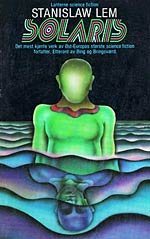
![]() charlesdee
charlesdee
3/2/2014
![]()
Packed into his landing module and jettisoned from an interstellar spacecraft, Kris Kelvin heads towards Solaris. Solaris is a watery planet that has been under Earth's observation for over a century. The consensus opinion holds that the ocean covering its surface is a single intelligent life form, but any detail of its nature or of the possibility of human communication with it has remained open to question. Over the past decade or so, interest in the planet has cooled among all but the most dedicated or obsessed Solarisists. The observation post on the planet was designed to house dozens of scientists. Kelvin will add a fourth to the three that are currently on board.
Kelvin lands on a strangely desolate facility. Even the robots are inactive. His one friend among the scientists on board has committed suicide. The others he believes are possibly insane. And they are not alone. A caricature of an African tribal woman stalks the hallways and the living scientists appear to hide living beings in their quarters. I associate Stanislaw Lem with the brainy comedy of his short fiction, but the opening chapters ofSolaris are as unnerving as any horror novel I have ever read.
Soon Kelvin has his own "visitor," a recreation of a past lover for whose suicide he feels responsible. The planet has created this being, perhaps in a misguided attempt to provide him a companion, perhaps to torture him, perhaps just to amuse itself, or perhaps as payback for a century of invasive experimentation. She is loving and complacent, and suffers physically when separated from Kelvin. He experiments with ways to remove her and to test his own sanity. This realization sums up the atmosphere Lem creates. "I was not mad," Kelvin reports. "My last ray of hope was extinguished."
Much of the novel involves Kelvin reviewing the history of Solaristics from the library on the research station. This might sound like a tedious plot device, but it is a kind of writing at which Lem excels. He uses these texts and Kelvin's memory of his own studies to recreate the initial excitement and grown frustrations the planet has provided its human visitors. Lem plays masterfully with the traditional SF theme of first encounters. In a slim, almost forgotten work by one Munitius, Kelvin finds what for Lem I suspect is the truest analysis of the encounter.
Solaristics is the space era's equivalent of religion: faith disguised as science. Contact, the stated aim of Solaristics, is no less vague and obscure than the communion of the saints, or the second coming of the Messiah. Exploration is a liturgy using the language of methodology; the drudgery of the Solarisists is carried out only in the expectation of fulfillment, of an Annunciation, for there are not and cannot be any bridges between Solaris and Earth.
In the novel's ambiguous conclusion, Lem creates a sense of grandeur around Kelvin's unresolvable desire to penetrate or possibly merge with this alien consciousness.
http://www.potatoweather.blogspot.com